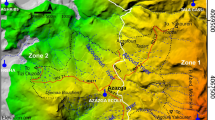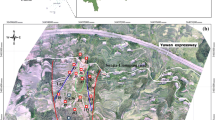Abstract
With increasing threat to lives and properties, identifying and assessing disaster potentials has become necessary and prior for effective disaster preparation and rescue planning. This study first introduces practical methods currently used in Taipei City, Taiwan, to identify and assess heavy rainfall–induced potential risks on flood, debris flow, and landslide. The identified disaster potential information is further applied to a series of deterministic and probabilistic risk analyses using Shilin District of Taipei City as a case study. The deterministic risk analyses are conducted to evaluate the impact of various heavy rainfall intensities on the residents. The probabilistic risk analyses are performed to establish risk curves for the population affected by heavy rainfall–induced hazards. The risk curve represents the relationships between the affected population and the annual exceedance probability. This study found the annual exceedance probability is very sensitive to the assumed coefficients of variation of the affected population. It is recommended historical statistical data on the correlation between affected population and rainfall intensity should be recorded and compiled in order to assess the actual probability distribution function of the affected population. Risk analysis results are further applied to assess the community evacuation capacity in this district. Last, short-term and long-term mitigation strategies and recommendations are discussed.















Similar content being viewed by others
References
Bonachea J, Remondo J, De Terán JRD, Gonzalez-Diez A, Cendrero A (2009) Landslide risk models for decision making. Risk Anal 29:1629–1643
Chen CY, Chen LK, Yu FC, Lin SC, Lin YC, Lee CL, Wang YT, Cheung KW (2008) Characteristics analysis for the flash flood-induced debris flows. Nat Hazards 47:245–261
Cheng KS (2001) Hydrological design manual. Water Resources Agency, Ministry of Economic Affairs
Cornell CA (1968) Engineering seismic risk analysis. Bull Seismol Soc Am 58:1583–1606
Crovelli RA (2000) Probability models for estimation of number and cost of landlsides. US Geological Survey open file report 00-249, p 23
GEO (2009) Aged villages investigation report in Taipei. Taipei City Geotechnical Engineering Office
GEO (2010) Debris-flow-prone streams and characteristics of rains triggering debris flows in Taipei. Taipei City Geotechnical Engineering Office
Gilbert RB (2008) Our role as engineers in mitigating natural hazards. In: Proceedings, geocongress 2008: geosustainability and geohazard mitigation, March 9, 2008–March 12, 2008, New Orleans, LA, United States
Hu K, Li Y, Wei F (2009) Annual risk assessment on high-frequency debris-flow fans. Nat Hazards 49:469–477
Jonkman SN, Kok M, Vrijling JK (2008a) Flood risk assessment in the Netherlands: a case study for dike ring south Holland. Risk Anal 28:1357–1374
Jonkman S, Vrijling J, Vrouwenvelder A (2008b) Methods for the estimation of loss of life due to floods: a literature review and a proposal for a new method. Nat Hazards 46:353–389
Jonkman SN, Maaskant B, Boyd E, Levitan ML (2009) Loss of life caused by the flooding of New Orleans after Hurricane Katrina: analysis of the relationship between flood characteristics and mortality. Risk Anal 29:676–698
Kim YO, Seo SB, Jang OJ (2012) Flood risk assessment using regional regression analysis. Nat Hazards. 4 Jun 2012 (Online)
Lai CC (2007) Characteristics of landslides caused by rainfalls and earthquakes in Taiwan. Master Thesis, Department of Hydraulic and Ocean, National Cheng Kung University
Lin GF (2010) Upgrading potential flooding map of Tamsui River, Taipei City, Taipei County, Taoyuan County and Keelung City. Water Resources Agency, Ministry of Economic Affairs
Lindell MK, Perry RW (2011) The protective action decision model: theoretical modifications and additional evidence. Risk Anal. 20 Jun 2011 (Online)
McGuire RK (1995) Probabilistic seismic hazard analysis and design earthquakes: closing the loop. Bull Seismol Soc Am 85:1275–1284
Merz B, Thieken A (2009) Flood risk curves and uncertainty bounds. Nat Hazards 51:437–458
Michael-Leiba M, Fred B, Greg S, Granger K (2003) Regional landslide risk to the Carins community. Nat Hazards 30:233–249
Minciardi R, Sacile R, Trasforini E (2009) Resource allocation in integrated preoperational and operational management of natural hazards. Risk Anal 29:62–75
MOEA (1988) Study and application of Taiwan hydrological data. Water Resources Agency, Ministry of Economic Affairs
Pande RK (2010) Flash flood disasters in Uttarakhand. Disaster Prev Manag 19:565–570
Paudel PP, Omura H, Kubota T, Morita K (2003) Landslide damage and disaster management system in Nepal. Disaster Preven Manag 12:413–419
Reiter L (1990) Earthquake hazard analysis-issues and insights. Columbia University Press, New York
Salciarini D, Tamagnini C, Conversini P, Rapinesi S (2011) Spatially distributed rainfall thresholds for the initiation of shallow landslides. Nat Hazards 61:1–17
Siegrist M, Gutscher H (2008) Natural hazards and motivation for mitigation behavior: people cannot predict the affect evoked by a severe flood. Risk Anal 28:771–778
TCFD (2010) Taipei disaster prevention manual. Taipei City Fire Department
Wang JJ, Ling H (2010) Relationships between typhoon types and debris flow disasters in Taiwan. Nat Hazards 54:373–394
Yang CJ (2006) Preliminary assessment of slope stability. Master Thesis, Department of Construction Engineering, National Taiwan University of Science and Technology
Acknowledgments
The finical support for this study was provided by the Taiwan Ministry of Interior under the grant for “Disaster Prevention and Protection Project of Taipei City.” The authors also would like to thank the Taipei City Fire Department, Geotechnical Engineering Office, and Hydraulic Engineering Office of Taipei City Government for providing valuable information and feedback for this study. Last, the authors sincerely appreciate the constructive comments by the anonymous reviewers.
Author information
Authors and Affiliations
Corresponding author
Rights and permissions
About this article
Cite this article
Chou, JS., Yang, KH., Cheng, MY. et al. Identification and assessment of heavy rainfall–induced disaster potentials in Taipei City. Nat Hazards 66, 167–190 (2013). https://doi.org/10.1007/s11069-012-0511-z
Received:
Accepted:
Published:
Issue Date:
DOI: https://doi.org/10.1007/s11069-012-0511-z




